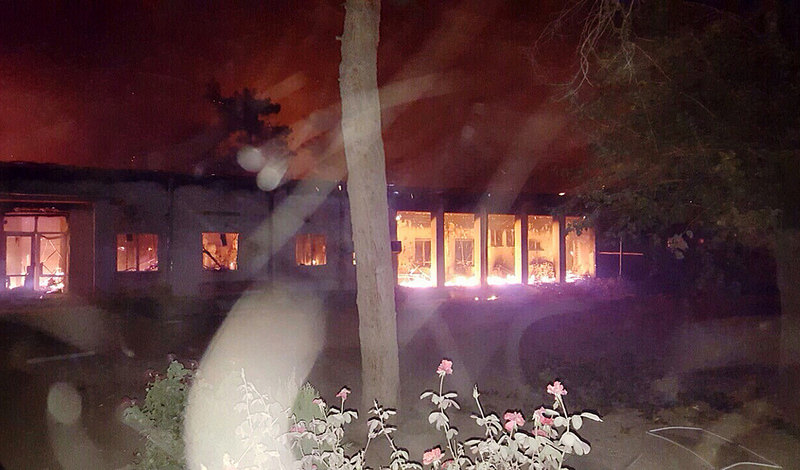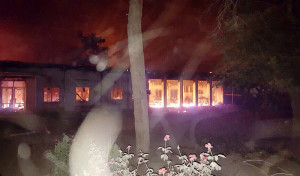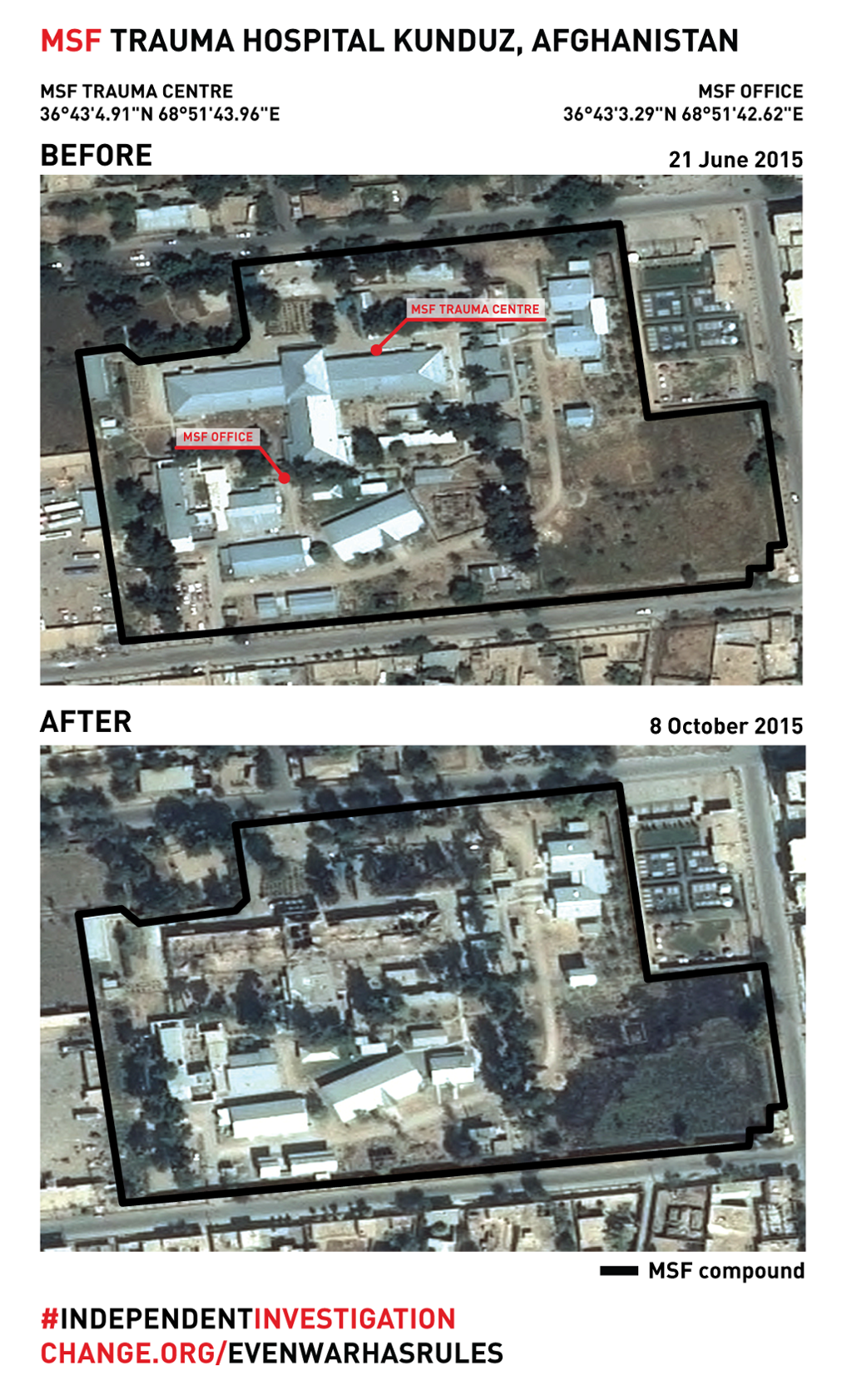The Human Cost of Human Error
 The MSF hospital in Kunduz burns after sustained aerial attack by the United States Air Force. (Photo credit: AFP Photo / MSF)
The MSF hospital in Kunduz burns after sustained aerial attack by the United States Air Force. (Photo credit: AFP Photo / MSF)
It has been, at time of writing, two months and one week since the U.S. airstrike on a Médecins Sans Frontières (MSF) hospital that killed at least thirty people. Among them were at least thirteen MSF staff and ten patients; seven bodies were burned beyond all identification. In the months since the attack, no independent report has been forthcoming. On December 9th, MSF issued a petition, with over half a million signatures,calling on the United States government to consent to an independent investigation of the attack. While the world awaits the U.S. government’s response, this is a good time to consider the facts of the attack, such as they have been established.
If anything has been consistent in the aftermath of the attack, it has been the inconsistency of the United States military’s explanation. On October 3rd, the day of the attack, the U.S. military’s spokesman in Afghanistan, Colonel Brian Tribus, referred to the attack as “collateral damage.” This has subsequently shown to be untrue – the evidence overwhelmingly suggests that the hospital was specifically targeted. In the words of MSF’s own report on the attack: “The main hospital building, which housed the intensive care unit, emergency rooms, laboratory, X-ray, outpatient department, mental health, and physiotherapy ward, was hit with precision, repeatedly, during each aerial raid, while surrounding buildings were left mostly untouched.” (Emphasis mine).

Nor has the military’s subsequent claim on October 4th, that U.S. forces were under attack from the hospital, held up to scrutiny. In a statement made on the 5th of October, General John Campbell, commander of the coalition forces in Afghanistan, admitted that American troops were not, in fact, claiming to have taken fire from the hospital, but that it was Afghan forces who requested the strike. Even this claim still has two troubling elements. The first is that MSF has insisted, and the U.S. military has confirmed, that no weapons were present in the Kunduz hospital, making the claim that fire had been coming from the hospital demonstrably untrue. The second is the implication that Afghan forces requested the attack. This is troubling in its own right because the Afghan government has a dark past with the very same hospital that was later bombed – in July, Afghan special forces raided the hospital and, threatening MSF personnel at gunpoint, arrested three of the patients in the hospital’s care before leaving without the patients. The Afghan government has objected to MSF’s treatment of Taliban combatants, though MSF has replied that its humanitarian mission requires it to treat all those in need, regardless of allegiance and that, under international law, the wounded in need of treatment are noncombatants by definition. This casts serious doubts over the intentions of the Afghan forces in Kunduz in calling for the airstrike – if indeed they are the ones responsible.
In all, over the course of the 3rd to the 6th of October, the United States military issued four statements that contradicted each other in varying degree. In and of itself, this is not surprising – initial reports of any event are, by nature, prone to error. What is unsettling is that even after revision and Congressional testimony, even more problems with the official story are coming to light. The United States military released a summary of its preliminary report on the bombing in November, in which it claimed a variety of factors – human, technical, and organizational – led to the bombing. The attack itself, it claimed, had fundamentally been due to human error. The report, while illustrative, cannot possibly be conclusive, compiled as it was by the very organization that stands to lose from an unfavorable investigation.
This brings us to present-day issues with the military’s story. For starters, contrary to what the lay person might imagine as an “airstrike” – a lone aircraft, high above the target – the plane that carried out the Kunduz bombing was an AC-130, a converted cargo aircraft that has to fly low in order to visually identify its target before opening fire. The attack, the U.S. military claims, was intended for a different target in Kunduz, which was being used by Taliban militants. Assuming what has been released of the official report is correct, even after the crew were informed of their mistake, they remained “fixated” on the original target, continuing to fire upon it even as they were given indications that the attack was misplaced. This, in and of itself, is tantamount to the admission of a war crime – U.S. military personnel willingly and knowingly continued firing upon a target after they were informed of its neutrality.

The second issue comes much more recently, and conflicts with the official claim that the hospital was not the intended target. In a letter to Secretary of Defense Ash Carter, Representative Duncan Hunter, member of the House Armed Services Committee, quoted unnamed U.S. servicemen present at the attack as saying that the Afghans requested the airstrike on the hospital specifically, claiming that it had been abandoned by MSF and overrun by Taliban combatants. If this is the case, it raises serious questions about the infrastructure responsible for authorizing airstrikes, as the coordinates and operations of the hospital were well-known to the United States military command in Afghanistan, with updated information being passed along as recently as September 29. In addition, the hospital itself sent out a distress call during the attack which went unheeded for seventeen minutes, in which time the AC-130 continued to fire on the hospital.
At present, three investigations are currently underway as to what truly occurred on October 3rd, one by NATO, one by the United States, and one by the Afghan government. There is grounds enough for suspicion with this information alone – all three investigators are either directly or indirectly implicated by the attack. American soldiers have already forced their way unannounced into the hospital in the aftermath of the attack, potentially destroying or otherwise compromising vital evidence. This was in violation of all investigating parties’ assurances that they would inform MSF of any investigation to take place on the former hospital grounds. If this is how the United States intends to carry out its investigation, an independent investigation, already an obvious necessity, becomes absolutely imperative.To that end, the International Humanitarian Fact-Finding Commission, an independent body provided for under the Geneva Convention to investigate war crimes but never before convened, has reportedly been activated. If the governments of the United States and Afghanistan give their consent, an independent investigation can finally begin.
In the meantime, the Kunduz trauma hospital, the only one of its kind in northern Afghanistan, has been closed, its surviving staff evacuated. In 2014, the MSF staff at the Kunduz hospital treated 22,000 patients. Now, the hospital is a ruin. One can only that hope an independent report can conclusively shed light as to why.
